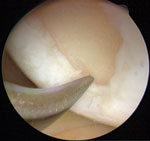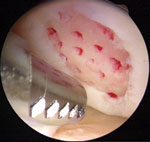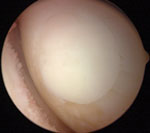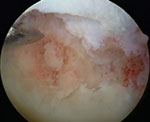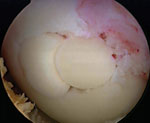Articular cartilage regeneration: Current status and future opportunities
It is becoming increasingly clear that we are inching our way toward achieving the goal of altering the natural history of cartilage damage.
by Douglas J. Wyland, MD; and Richard Hawkins, MD
As our population ages, we are not necessarily slowing down. While some “boomers” are fine with activities of daily living serving as their main form of exercise, many are still participating in fairly demanding sporting endeavors. Today’s patients simply desire greater function with less pain as they pursue their life’s activities. Unfortunately, the pain and disability caused by degenerative joint disease (DJD) and traumatic cartilage defects can veer us all a little off track, but it does not have to be this way.
Through the past several years, orthopedic investigators have developed myriad surgical techniques which have been shown to improve our patients’ underlying cartilage problems – and lifestyles. As we learn from the plethora of ongoing global research efforts and develop future treatment strategies, it is becoming clear that we are inching closer to achieving our goal of altering the natural history of cartilage damage. Future cartilage regeneration programs will likely consist of a comprehensive orchestration of patient-matched treatment elements aimed to enhance the cellular, intra-articular and extra-articular environment in order to optimize cartilage preservation and restoration.
Chondroprotection
The concept of preserving and protecting articular cartilage is not new, although delivering on this worthy goal has been challenging. Several current nonoperative options provide hope, and breakthroughs are on the horizon which may actually deliver.
|
|
Injectables such as viscosupplementation with hyaluronic acid (HA) appear to be a beacon of light in the midst of many offerings for joint preservation, and may serve as a core treatment in achieving joint restoration. On a cellular level, HA injections may work by favorably altering the delicate balance of pro-inflammatory cytokines (TNF-a, IL-1) and the chondroprotective agents (TGF-b IGF-1) in the degenerative joint. Grossly at the intraarticular level, HA improves the viscoelasticity of synovial fluid by improving shock absorption and lubrication.Clinically, stand-alone HA injections can provide lasting pain relief and decreased joint inflammation over simple cortisone injections. Perhaps more exciting though, HA injections may play a role in cartilage repair and preservation through decreasing surface fibrillation and even improving chondrocyte viability after traumatic surface damage.
Other injectables
Other injectables such as platelet-rich plasma (PRP) and stem cells are being studied for intra-articular use. PRP has been shown to decrease DJD progression in an animal model, and clinically has been shown to decrease pain and increase function. Injected stem cells suspended in HA have shown promise by inducing healing of partial-thickness traumatized porcine cartilage. Although still in the lab, we are learning that chondrocyte death which occurs after cartilage impact can be diminished by the introduction of the antioxidant N-acetylcysteine.
|
|
|
|
|
|
|
|
|
This patient had two lesions of the medial femoral condyle. One area had good enough bone quality for microfracture (top, left to right) and the other area had more osteonecrosis (bottom, left to right) thus requiring a single osteoeochondral autograft. Images: Wyland DJ |
||
Strongly marketed oral supplements such as glucosamine and chondroitin sulfate are clinically attractive and show some promise for pain and inflammation relief. Yet along with many other oral supplements such as dimethyl sulfoxide (DMSO), methylsulfonylmethane (MSM) and even seaweed extracts, the current scientific evidence is too thin to recommend these as protective or restorative agents. It is worth noting however, this was also the thought in the early days of viscosupplementation, so we’ll stay tuned.
It is important that we consider the chondroprotective effects of unloading the affected cartilage. This can be achieved by bracing, or surgically with osteotomy — while also addressing the meniscus more aggressively with repair, replacement with allograft or the promising future offering of biosynthetic graft with collagen meniscal implant. We should also consider maximizing the extra-articular environment by properly gaining dynamic strength, coordination and proprioception of the limb. Of course, these additions to the program become essential considerations when treating the patient with surgical techniques designed to preserve and restore cartilage.
Surgical techniques
We have learned over the last 2 decades that even though the resultant cartilage produced by our tried-and-true cartilage regeneration procedures is often fibrocartilage, they usually result in good clinical outcomes. Building on the solid foundation of these techniques, more sophisticated future advances are aiming to achieve our goal of reproducibly preserving, repairing and restoring the more desired hyaline cartilage.
Marrow stimulation techniques (MST) such as microfracture, are the original cell-based therapy and remain the simplest and most cost-effective surgical treatment for localized full-thickness cartilage lesions. MSTs introduce undifferentiated mesenchymal stem cells to the prepared lesion and form a superclot which develops ultimately into fibrocartilage. Newer reports show that simply introducing HA to the post-microfractured joint decreases pain and improves the histologic appearance of the cartilage regenerate. Preparations of BMP-2 and 7 have also shown promise when introduced in similar animal models.
Autologous chondrocyte implantation (ACI) is a cell therapy that is swiftly moving from first to third generation techniques. The first generation procedure currently offered in the United States is a somewhat cumbersome and expensive strategy requiring two operations, yet unfortunately results in only equivocal clinical and histological outcomes as compared to the MSTs.
Future opportunities
The future of chondrocyte cell therapy techniques is quite exciting. Good early clinical and histologic results have been reported using third-generation transarthroscopic matrix-induced ACI (MACI), which combines collagen l/lll and hyaluronan scaffolds with autologous chondrocytes and fibrin glue placed into the lesion [Hyalograft-C, Fidia SpA]. Another offering in the cell implantation category includes techniques such as the cartilage autograft implantation system [CAIS, DePuy Mitek] and DeNovo NT- Natural Tissue Graft [Zimmer], which deliver to the defect a preparation of minced articular cartilage, combined with copolymers and fibrin glue. Closer to the horizon of clinical introduction are other tissue-engineering strategies aimed to convert more accessible sources of stem cells, such as adipose tissue, into differentiated chondrocytes that could be placed into a growth-factor laced scaffold and introduced into the chondral lesion.
|
|
|
|
|
This patient had an osteochondritis dessicans lesion on the medial femoral condyle. It required mosaicplasty with autograft. |
||
Osteochondral grafts (OCG) procedures are not exactly cartilage regeneration, but the adjuvant use of autologous and allogeneic tissue grafts belong in our joint restoration discussion because OCGs offer a rather immediate option to restore damaged hyaline cartilage and bone. Future directions for OCG usage will likely see us combining growth factors and chondroprotective agents to the already successful procedures in order to further enhance the incorporation of the graft borders.
Indeed, in the next 20 years we may realize our goal of successfully creating fairly simple, reproducible arthroscopic procedures which result in durable native-like hyaline cartilage regenerate.
Joint restoration programs
The future is already here in some centers, as we develop perhaps a new paradigm for joint restoration by integrating enhancements of the cellular, intra-articular and extra-articular environments. From the outset, we will strive to create a sophisticated and comprehensive joint restoration program for each individual patient. The “al la carte” program will be created by the patient and physician and may include elements such as wellness and therapy, nutrition and supplementation, bracing and injectables, and, if necessary, the application of appropriate surgical techniques.
We are hopeful that matching patient desires and expectations with the correct combination of treatment elements will improve outcomes in patients with both degenerative and focal cartilage disease.
References:
- Ahmed TA, Hincke MT. Strategies for Articular Cartilage Lesion Repair and Functional Restoration. Tissue Eng Part B Rev. 2010; Jan 30. Epub ahead of print.
- Jansen EJ, Emans PJ, Douw CM, et al. One intra-articular injection of hyaluronan prevents cell death and improves cell metabolism in a model of injured articular cartilage in the rabbit. J Ortho Res. 2008;May;26(5):624-630.
- Douglas J. Wyland, MD, and Richard J. Hawkins, MD, can be reached at the Joint Restoration Institute, Steadman Hawkins Clinic of the Carolinas, 200 Patewood Drive, Suite C100, Greenville, SC 29615; 864-454-7422.



